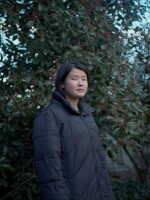For nearly two years, the Chauvin Sculpture Garden’s dozens of folk art works have sat in the Chauvin park damaged and vandalized, mostly due to Hurricane Ida. But now, officials are finally making repairs to the beloved outdoor art space.
Community officials at the annual Folk Art Festival, which took place in the garden, unveiled some repairs that started in January and announced that more were underway.

Those repairs included making the structures more resilient for future storms. University of Texas, San Antonio professor Greg Elliot was responsible for the fixes, adding piping and fortification to anchor the pieces to the ground so that the artwork is better prepared to take on hurricane winds.
Wind was a major cause of the damage, even bending some of the structures. To fix this, Elliot cut the sculptures’ legs off their base, then added new cement and replaced their metal mesh. Volunteers are also helping with repainting the art.

Chauvin Sculpture Garden coordinator Gary LaFleur said that the park was just one of the many examples in town that were experiencing slow recovery. A drive through this bayou community nearly two years after Ida still shows the scars from the catastrophic hurricane, with blue tarps still attached to roofs, FEMA trailers set up, and some homes completely destroyed and abandoned.
“The community is healing — that's what it feels like,” LaFleur, also the Center for Bayou Studies director at Nicholls State University, said. “It's a healing process.”
LaFleur said that the sculpture garden was always a place of pride for residents. Located about an hour-and-a-half southwest of New Orleans, the sculpture garden was built in the 1990s by bricklayer Kenny Hill over the span of 10 years.
During this time, a magical landscape took shape in a small grassy park, with sculpture art depicting World War 2, Jesus, angels and self-portraits of Hill. The art was created with metal piping, concrete, brick and paint.
Before it was damaged, it would attract tens of thousands of visitors each year to see its more than 100 permanent installations to the park, including its popular centerpiece: a prominent 45-foot-tall lighthouse next to the bayou, with soldiers, musicians and cowboys wrapping around the outside of the structure.
“In the town of Chauvin, (residents) know to expect shrimpers and that they're close to the coast. But no one knows to expect a world class sculpture garden,” LaFleur said.

At the Folk Art Festival, artists had set up shop to sell ink block prints and handmade mugs featuring bayou wildlife, while families danced to local bands on the sculpture garden grounds. Many were delighted to hear the news of the long overdue repairs being done to the gardens.
“I love it,” said Lisa Gostev, who showed her kids the garden as repairs were being made . “I mean, just to see the joy that it brings people in the community, having everyone together and enjoying art-making and regional artists that are very specific to the area – it's inspiring to see.”
For Quenton Fontenot, a musician in the Cajun Preserves band, it’s one of the few places in the area where local culture — and the people who make it — is showcased and celebrated.
“People down the bayou are so creative,” Fontenot said. “We got our own type of art, our own type of music, our own type of language and our own type of cooking. And it's nice to see all of it come together as we celebrate this culture.”



